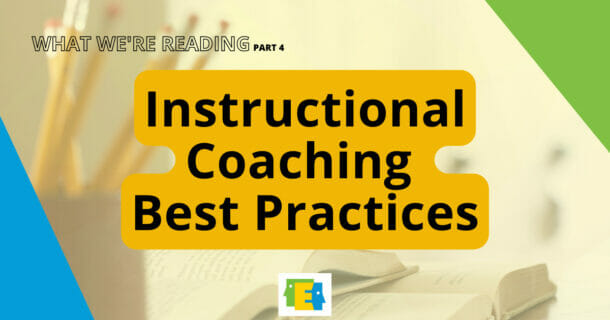What We’re Reading: 3 Resources for Instructional Coaching Best Practices

Coaching is a core element of supporting teacher learning and growth. Whether provided by a principal after a classroom observation or district curriculum specialist leading a PLC, instructional coaching best practices are important for consistent coaching.
For school leaders and administrators thinking about the most effective coaching for their teachers, there’s a lot to consider, including:
- which teachers, from new to veteran, can benefit from coaching,
- obstacles, such as “teacher resistance” to coaching processes, and
- instructional coaching best practices for building trust and connection with teachers
We’ve rounded up three resources that provide instructional coaching best practices to keep in mind when designing or providing coaching experiences for educators.
Check out the highlights of what we’ve been reading below, as well as links to the full resources.
Don’t coach just new teachers – experienced teachers need instructional coaching, too
As my career advanced, I realized that anything resembling a coaching opportunity was usually a byproduct of instructional planning. The beginning and end of coaching for many teachers occurs in the early years of their careers.
This Edutopia article emphasizes the importance of providing instructional coaching to teachers throughout all the years of their careers.
Perhaps coaches don’t want to “bother” more experienced teachers with more on their plates, or it’s been perceived that veteran educators are doing well enough on their own.
This article provides rationale for the instructional coaching best practice of providing coaching and learning opportunities to all teachers.
“Often, the most intensive coaching is provided during the early years, but this support tends to wane as teachers gain experience and appear more self-sufficient.
Such a decline in support can inadvertently promote learned helplessness. There is also a misconception that experienced teachers do not require or desire coaching, which can be detrimental to their continuous growth.”
Indeed, for all teachers to show continuous improvement in the classroom, they need some form of instructional coaching and development.
Read more about how instructional coaching serves as professional development for all teachers at Edutopia: The Case for Instructional Coaching Throughout a Teacher’s Career
Teachers not engaged in your school’s instructional coaching? Try these strategies
Instructional coaching best practices must include creating teacher buy-in.
For coaching to be effective in strengthening classroom practice, teachers should be active participants in their learning and professional development.
This ASCD article shares six strategies for what might be called “teacher resistance” to coaching.
Here are two strategies:
- Provide practical classroom solutions.
For your first coaching meeting, pick a focus area that is small and manageable and will help the teacher see immediate results with their students.Coaching should focus on bite-sized, practical strategies and skills that teachers can directly apply to their classrooms. Seeing a win in the classroom because of your coaching is one of the best ways to help a teacher buy in. - Celebrate together.
Share “glow” areas in a positive tone with concrete data in every coaching meeting, such as how the percent of students on-task throughout the lesson has grown. Celebrating the positive helps to decrease defensiveness or fear of judgment.
Read the rest of the strategies for getting teachers more engaged in instructional coaching at the ASCD blog: Coaching “Resistant” Teachers
Do your teachers need bite-sized classroom solutions? Learn how AI Coach by Edthena provides personalized classroom strategies aligned to teachers’ unique professional goals.
Instructional coaching best practices for building trust and connection with teachers
Strong instructional coaching is rooted in relationships and trust with teachers.
As this blog post from NAIS emphasizes, “At its core, the shared work between coach and teacher is deeply relational, founded on trust in the partnership and a shared commitment to lifelong learning and equity in the classroom.”
This resource outlines key best practices and principles to incorporate when thinking about how to provide strong instructional coaching school- or districtwide.
Here are the first two instructional coaching best practices:
- Trust. At the heart of every instructional coaching program is trust. When it exists between a coach and teacher, the coaching relationship can be teacher-driven, nonevaluative, confidential, and relational—these are the key ingredients to transformation. The best way to establish trust with teachers is to stay focused on what builds and sustains a trusting relationship in any realm: being empathetic, dependable, nonjudgmental, responsive, and attentive.
- Connection. Early coaching conversations include time and space for exploring the peaks and valleys of one’s professional journey, the teacher’s self-identified strengths and struggles, and the core values that guide the teacher’s practice. Through conversations, planning sessions, small-group workshops, and classroom visits, the coaches get to know and understand what is happening across learning spaces. This perspective allows them to connect colleagues with one another to nurture a deepening of skill sets and a sense of belonging.
Read the rest of the instructional coaching best practices and principles at Independent Ideas:
Instructional Coaching: 5 Principles for a Successful Practice
Get more instructional coaching conversation tips that put teachers first in our blog post: Jim Knight on How To Ask Questions That Highlight Teacher Brilliance




